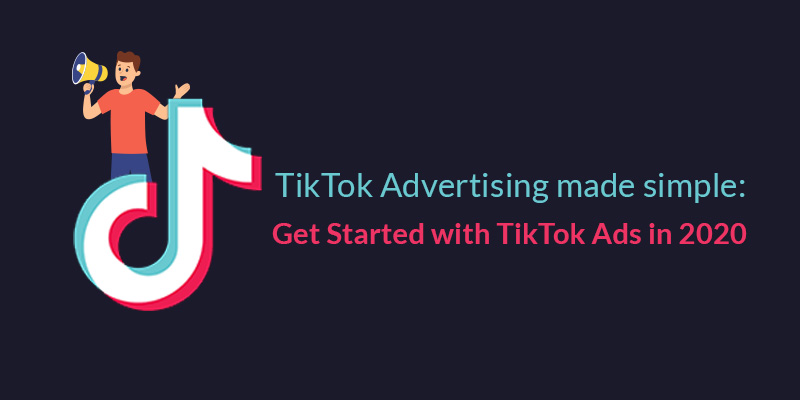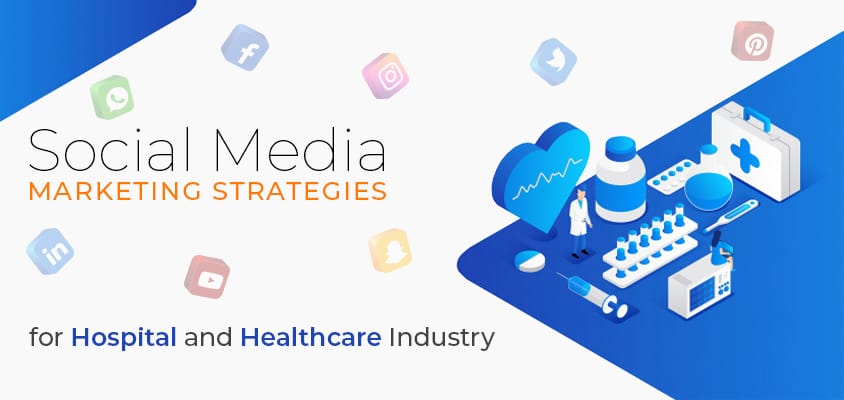
How to Create Successful Hospital Marketing Strategy [Updated 2023]
September 19, 2019
TikTok Advertising: The Quickstart Guide to Get Started with amazing Tiktok Ads (2024)
October 24, 2019The Importance of Social Media in the Healthcare Industry
The changing landscape of hospital and healthcare and their social media marketing strategy has evolved in the past few years.
Hospital marketers now use social media as a tool for connecting with consumers, and healthcare practices are beginning to use social marketing to reach out to their patients and potential patients.
It provides a platform for connecting with patients, sharing vital health information, and fostering community engagement.
There's no denying that effective social media marketing can enhance a hospital's reputation and expand its reach. For instance, think about the last time you searched for health advice; chances are you turned to social media. Hospitals can leverage this trend by sharing:
- Health Tips: Quick, actionable advice for everyday wellness.
- Patient Testimonials: Real stories that resonate and instill trust.
- Event Announcements: Information on health fairs, immunization drives, and workshops.
Hospitals are increasingly using social media for patient engagement and support, creating a more profound connection that fosters loyalty.
Trends and Challenges in Social Media Marketing for Hospitals
While the benefits of social media are clear, hospitals face unique challenges. For example, staying compliant with Digital Information Security in Healthcare Act (DISHA) regulations while maintaining a vibrant online presence can be tough. Key trends include:
- Increased Video Content: Short, informative videos capturing patient experiences.
- Focus on Community Engagement: Using platforms to build relationships, not just promote services.
Hospitals must navigate these waters carefully, balancing innovative strategies with compliance and ethical considerations to truly succeed in their social media efforts.

Establishing a Strong Social Media Presence
Creating a Consistent Brand Image
Establishing a robust social media presence starts with creating a consistent brand image. Just like a friendly neighborhood doctor who greets you with a familiar face, your hospital’s social media profile should communicate trust and reliability. To achieve this, consider the following:
- Visual Identity: Use consistent colors, logos, and fonts in all posts to establish brand recognition.
- Tone and Voice: Decide whether your approach will be formal, friendly, or a mix. This uniformity builds familiarity.
- Content Themes: Create content categories such as health tips, patient stories, or promotional events that resonate with your audience.
For example, some hospitals have successfully used social media to showcase their team of doctors, turning staff members into brand ambassadors.
Engaging with Patients and the Community
Engagement is essential in making social media a two-way street. It’s not just about posting updates; it’s about fostering conversations. Hospitals can enhance this engagement through:
- Interactive Posts: Polls, quizzes, and Q&A sessions about health topics.
- Community Events: Promote involvement in local events or health fairs.
By actively engaging with patients and the community, hospitals can build a loyal following and create a sense of belonging.
Little interactions can lead to significant relationships—trust me, those moments are what make your social media strategy truly shine.
Strategies for Effective Content Creation
Leveraging Educational and Informative Content
To create content that resonates with your audience, focus on providing educational and informative resources. After all, patients are always hungry for knowledge about their health, and hospitals can serve as invaluable sources of information. Consider these content ideas:
- Health Tips and Tricks: Simple advice that patients can easily apply, such as nutrition tips or exercise routines.
- Webinars and Live Q&A Sessions: Hosting online events where experts can share insights and answer questions in real-time can establish your hospital as a trusted resource.
- Infographics: These can break down complex information into digestible visuals, making it easier for your audience to understand critical topics.
For example, a local hospital might create a series of infographics on heart health during February’s Heart Month, gaining engagement and shares across social platforms.
Utilizing User-Generated Content
User-generated content (UGC) can significantly boost engagement while reinforcing community trust. UGC is not only authentic but also showcases real experiences. Strategies include:
- Patient Testimonials: Encourage patients to share their stories, which can be featured on your social media pages.
- Photo Contests: Host contests where patients share photos taken during healthy events at your hospital, increasing interaction and community spirit.
By combining educational content with user-generated content, hospitals can establish a dynamic online presence that fosters interaction, cultivates trust, and engages their audience in a more genuine manner. Remember, real stories speak volumes!

Best Practices for Facebook Marketing
With Facebook, it’s essential to recognize its vast potential for marketing in the healthcare sector. With an audience that spans multiple age groups, your hospital can connect with various demographics effectively.
To maximize your Facebook presence, consider these best practices:
Post Regularly: Consistency is key. Aim for at least 3-4 posts per week to keep your audience engaged.
Utilize Live Features: Facebook Live is a fantastic way to host virtual seminars or Q&As with healthcare professionals. Real-time interactions can significantly boost engagement.
Create Shareable Content: Infographics, health tips, and heartwarming patient stories can encourage your followers to share, extending your reach.
For example, a hospital might run a campaign during flu season, sharing preventative tips and encouraging local families to get their vaccinations.
Engaging with Audience on X Platform (formerly Twitter)
X is all about fast-paced communication and real-time updates. For healthcare organizations, this means being responsive and engaging in ongoing conversations.
Here are a few tips for successful Twitter engagement:
Use Hashtags Wisely: Incorporate trending health-related hashtags to increase visibility.
Participate in X (Twitter) Chats: Join conversations on relevant topics, allowing your team to showcase expertise while connecting with your audience.
Respond Quickly: Quick and thoughtful replies to questions or concerns can demonstrate your hospital's commitment to patient care.
Best Practices for Instagram Marketing
Instagram serves as a visually-driven platform that allows healthcare organizations to connect with their audience creatively and engagingly.
Here are some best practices to consider:
Leverage Visual Storytelling: Use high-quality images and videos to share compelling patient stories, staff highlights, or visually appealing health tips. Strong visuals can evoke emotions and foster connections with your audience.
Utilize Instagram Stories and Reels: Engage your audience using stories and short videos. These formats are perfect for sharing quick health tips, behind-the-scenes looks, or updates on hospital initiatives. This content is often favored in users' feeds, increasing visibility.
Engage with Your Followers: Use features like polls, questions, and stickers in your stories to interact with your audience. This not only boosts engagement but also provides insights into their preferences and concerns.
Incorporate Relevant Hashtags: Research and use popular health-related hashtags and local hashtags to increase your posts' discoverability and reach a wider audience.
Showcase Community Involvement: Highlight your organization’s participation in community health events, partnerships with local organizations, and wellness initiatives. This helps build trust and positions your hospital as a community leader in health.
Effective strategies on Facebook, Twitter, and Instagram, healthcare organizations can create a dynamic online presence, nurture relationships, and convey valuable health information to the community.
Implementing Social Media Advertising in Healthcare
Targeting Specific Patient Demographics
Once you've established a solid presence on social media, it's time to harness the power of advertising to reach specific patient demographics. Unlike traditional media, social media platforms like Facebook and Instagram enable you to tailor your ads to virtually any audience, significantly enhancing your marketing efforts.
Strategies for Effective Targeting:
Use Data Analytics: Leverage insights from your social media pages to understand who engages with your content. According to a recent report from Hootsuite, 94% of healthcare consumers research online before making a healthcare decision, making it crucial to know your audience's age, location, and interests.
Create Buyer Personas: Develop detailed profiles for your ideal patients. Research by HubSpot suggests that companies with well-defined buyer personas can increase their conversion rates by up to 73%. By clearly identifying the needs and preferences of these personas, you can create more focused and effective ad content.
Utilize Custom Audiences: Facebook’s Custom Audiences feature allows you to re-target previous patients or individuals who have engaged with your content. This can lead to a significant increase in engagement; Facebook reports that re-targeting can increase conversion rates by up to 150%.
For instance, if a hospital is promoting a prenatal class, utilizing precise demographics to target expectant mothers in the local area can significantly boost attendance. In fact, 55% of mothers-to-be use social media to seek health information, making it an effective platform for outreach.
Measuring and Analyzing Advertising ROI
After running your ads, measuring their success is crucial. Analyzing your return on investment (ROI) ensures you're maximizing the impact of your marketing budget.
Key Metrics to Measure Effectiveness:
Track Click-Through Rates (CTR): This metric indicates how many people clicked on your ad compared to how many saw it. The average CTR for healthcare ads typically hovers around 3.50%, according to Wordstream. Higher CTRs often suggest that your audience finds your content engaging and relevant.
Monitor Conversions: Use conversion tracking to determine how many ad viewers took the desired action, such as booking an appointment or signing up for a wellness program. According to a study from the Digital Marketing Institute, effective conversion tracking can increase your campaign’s ROI by as much as 200%.
Adjust and Optimize: Continuously analyze performance data and refine your campaigns based on these insights. For example, if an ad focused on weight loss management generates significant conversions, consider reallocating budget from less effective campaigns. A/B testing different ad formats and content can also reveal what resonates best with your audience.
For example, if an ad focused on weight loss management generates significant conversions, consider reallocating budget from less effective campaigns.
Where over 80% of healthcare marketers believe social media is essential for brand promotion, leveraging these practices is more important than ever.

Managing Online Reputation and Patient Feedback
Responding to Reviews and Comments
Today, potential patients often look at reviews and comments before choosing a hospital. This makes your response strategy just as important as the quality of care you provide. To build a positive online presence, consider these tips:
- Be Prompt: Aim to respond to comments and reviews within 24 hours. Timeliness shows that you value patient feedback.
- Personalize Responses: Address reviewers by name and reflect on their specific concerns to foster a personal connection.
- Thank Patients: For positive reviews, expressing gratitude can encourage loyalty and further engagement.
An example might include a hospital responding to a glowing review about a successful surgery, thanking the patient while offering an invitation to follow their social media for health tips.
Handling Negative Feedback and Crisis Communication
Negative feedback is an inevitable part of online presence, but how you handle it can shape your organization’s reputation. Here’s how to manage it effectively:
- Stay Calm and Professional: Don’t take criticism personally; instead, respond diplomatically.
- Acknowledge Concerns: Let patients know their feedback is valid and important.
- Take Conversations Offline: If a situation escalates, offer to discuss the matter privately to resolve it.
For instance, if a patient expresses dissatisfaction with wait times, a compassionate response might invite them to share more details privately, demonstrating that their experience matters.
Compliance and Privacy in Social Media Marketing
Digital Information Security in Healthcare Act (DISHA) Regulations and Guidelines
In the healthcare sector, compliance with the Digital Information Security in Healthcare Act (DISHA) is non-negotiable, especially when navigating social media marketing. DISHA guidelines are designed to protect patient privacy and ensure that sensitive information is handled securely. Here are key points to consider:
- Avoid Personal Health Information: Never share patient-specific information or any details that could identify individual cases without explicit consent.
- Educate Staff: Ensure that all team members understand HIPAA regulations and the importance of safeguarding patient information when using social media.
- Use Secure Platforms: Opt for secure communication channels for any patient-related discussions, steering clear of public forums.
For example, when a hospital shares a success story about a treatment, it should always anonymize the patient’s details to remain compliant.
Ensuring Patient Data Security
Ensuring the overall security of patient data is paramount. As hospitals engage in social media, being vigilant about data protection is crucial.
Consider these strategies:
- Implement Strict Access Controls: Limit social media account access to authorized personnel only.
- Regularly Review Privacy Settings: Keep your social media accounts’ privacy settings up-to-date to avoid unintended data exposure.
- Train Staff on Cybersecurity: Provide regular training on recognizing phishing attempts and safeguarding sensitive data.
Prioritizing compliance and security in social media marketing strategies, healthcare organizations not only protect patient information but also build trust—an invaluable asset in today’s digital landscape.
This proactive approach demonstrates a commitment to patient safety and privacy, reinforcing a hospital's ethical foundation.
Collaborating with Influencers and Partners
Building Relationships with Healthcare Influencers
Partnering with healthcare influencers can tremendously expand your hospital's reach and credibility. These individuals often have established trust within their communities, making them powerful allies in the quest for patient engagement.
To build strong relationships with influencers, consider the following:
- Research Potential Influencers: Look for individuals who align with your hospital’s values and have a relevant audience interested in health topics.
- Engage Authentically: Start by engaging with their content—like, comment, and share their posts. This fosters a genuine connection before proposing collaborations.
- Offer Value: When reaching out, propose ideas that benefit both parties, such as co-hosting health events or educational webinars.
For instance, collaborating with a local nutritionist on a “healthy living” series can draw attention while providing valuable community insights.
Partnering with Healthcare Organizations for Campaigns
Beyond influencers, collaborating with other healthcare organizations can amplify your message and resources. Joint campaigns can lead to greater community impact while sharing costs and expertise. Here are ways to approach these partnerships:
- Identify Common Goals: Find organizations with similar missions or health initiatives to collaborate on campaigns, events, or awareness drives.
- Share Resources: Pool resources, expertise, and audience reach to create impactful health promotion efforts.
- Co-brand Initiatives: Ensure both parties are represented in campaigns, showcasing unity and reinforcing messages.
For example, a hospital might team up with a local health department to promote vaccination awareness through joint social media campaigns, maximizing outreach efforts. Measuring Success and ROI in Social Media Marketing
Key Metrics to Track for Hospital Social Media
To determine the effectiveness of social media marketing initiatives for hospitals, it's crucial to track specific metrics that reveal audience engagement and campaign performance. Here are some key metrics to focus on:
- Engagement Rate: This includes likes, shares, comments, and overall interaction with your posts, which indicates how well your content resonates with your audience.
- Reach and Impressions: Measure how many people see your posts and how often. A high reach suggests effective visibility within the community.
- Follower Growth Rate: Tracking the growth rate of your followers over time helps assess the interest in your hospital’s content.
For example, a hospital might notice a spike in engagement during a health awareness campaign, signaling effective outreach and strong audience interest.
Calculating Return on Investment and Attribution
Calculating your social media marketing ROI goes hand in hand with tracking these metrics. Here’s how to measure it effectively:
- Define Goals: Start by outlining specific goals for your campaigns, whether that’s increasing patient inquiries or promoting a health event.
- Analyze Cost vs. Revenue: Assess how much you spent on the campaign against the returns in terms of new patients or appointments generated.
- Attribution Models: Use attribution models to determine which channels or posts contributed most to achieving your goals, helping you allocate resources effectively.
For instance, if a paid social ad directed a significant number of inquiries for a new service, that data signifies a strong ROI.
Focusing on these metrics, hospitals can fine-tune their social media strategy, ensuring that marketing efforts yield tangible results and growth in community engagement.
Future Trends and Innovations in Healthcare Social Media Marketing
Artificial Intelligence in Social Media Strategy
As technology continues to evolve, artificial intelligence (AI) is set to play a transformative role in healthcare social media marketing.
AI can streamline processes, enhance targeting, and personalize patient interactions. Consider these potential applications:
- Chatbots for Patient Interaction: Use AI-driven chatbots to handle common inquiries and provide instant support, freeing up staff for more complex issues.
- Content Personalization: AI algorithms can analyze user behavior and preferences to deliver tailored content, improving patient engagement.
- Predictive Analytics: By analyzing data trends, AI can help predict which types of posts will resonate most with your audience, guiding content creation.
For example, a hospital might implement a chatbot on its socials to answer FAQs, ensuring timely responses and enhancing the patient experience.
Virtual Reality and Augmented Reality Applications
Another exciting frontier is the use of virtual reality (VR) and augmented reality (AR) in healthcare marketing. These technologies can revolutionize patient education and community engagement.
Explore these innovative uses:
- Virtual Tours: Hospitals can offer virtual reality tours of facilities, easing patient anxiety before visits and fostering familiarity with the environment.
- Augmented Reality Health Education: AR applications can enable users to visualize complex health information or demonstrate procedures interactively, making learning more engaging.
For instance, a health organization might deploy an AR app where users can visualize how a procedure works, enhancing understanding and trust.
AI, VR, and AR can help healthcare organizations improve marketing and enhance patient interactions and education, leading to better and more connected healthcare experiences.
Case Studies and Success Stories in Healthcare Social Media Marketing
Examples of Effective Social Media Campaigns
Real-world case studies illustrate the power of social media marketing in healthcare. One notable example is the “#ThisIsMyWhy” campaign launched by a major health system aimed at sharing personal stories behind patients’ health journeys.
Key highlights from this campaign include:
- Emotional Engagement: By encouraging patients to share their “why,” the campaign created a heartfelt connection and fostered community involvement.
- Wide Reach: The hashtag went viral, reaching tens of thousands of users and significantly increasing the health system's visibility.
- Increased Following: The campaign resulted in a notable boost in social media followers, enhancing the organization’s overall digital presence.
Lessons Learned from Failed Healthcare Social Media Marketing Efforts
Not all campaigns are successful, and analyzing failures can be just as enlightening. A hospital’s attempt to promote a new weight loss program via social media faced backlash due to perceived insensitivity in messaging. Lessons from this example include:
- Know Your Audience: Understanding the target demographic is vital; insensitive content can alienate potential patients.
- Test Messaging: Before launching a campaign, pilot messages with focus groups to gauge reactions and adjust accordingly.
- Crisis Management: Always have a strategy to address negative feedback quickly.
Learning from both successes and failures, healthcare organizations can refine their social media marketing strategies, paving the way for more impactful and respectful engagement with their communities.
Social Media Dos and Don'ts for Hospitals and Healthcare Marketing
Navigating social media successfully requires hospitals to follow some key dos and don'ts: Dos:
- Establish a consistent brand identity
- Engage actively with followers through comments and shares
- Use visuals to convey health messages effectively
Don'ts:
- Never share patient information without consent
- Avoid controversial topics that could alienate your audience
Healthcare organizations can leverage social media effectively, making it a powerful tool in their marketing strategy.
Dos for Hospitals on Social Media
Establishing a Strong Brand Presence
Developing a robust brand presence on social media is crucial for hospitals. This means showcasing not just services but also the values and culture of the organization. For instance, sharing stories of patient success can profoundly resonate with followers. Hospitals should:
- Create a recognizable logo and tagline: This helps in creating brand consistency across platforms.
- Post regularly: This keeps the audience engaged and informed.
- Share behind-the-scenes content: Showcasing staff and community events humanizes the brand.
Engaging with Patients and Followers
Engagement is key to building relationships. Hospitals should prioritize interactive content to foster a sense of community. Examples include:
- Responding to comments and messages: This shows that the hospital cares about patient feedback.
- Hosting Q&A sessions: This can clarify health-related queries and demonstrate expertise.
- Running patient testimonials: These can be showcased on various platforms, enhancing authenticity.
By focusing on building a strong brand and engaging meaningfully with patients, hospitals can cultivate loyalty and trust within their communities.
Don'ts for Hospitals on Social Media
Sharing Patient Information
One of the most critical don'ts for hospitals on social media is sharing patient information. Maintaining confidentiality is paramount. For instance, even if a patient expresses gratitude publicly, a hospital should refrain from sharing details about their case without explicit consent. Protecting patient privacy builds trust and adheres to legal standards like HIPAA. Remember:
- Never post identifying details: Patient names, images, or specific health data should never be shared.
- Educate staff: Regular training can help ensure everyone understands the importance of confidentiality.
Engaging in Controversial Topics
Another vital point to remember is to steer clear of controversial topics. While it may seem appealing to engage in trending discussions, doing so can alienate portions of the audience. For instance, discussions regarding politics or personal beliefs can lead to divisive opinions. Here’s what to consider:
- Stick to health-related topics: Focus on providing informative and educational content.
- Avoid heated debates: Leave controversial opinions out of your posts to maintain professionalism.
Avoiding these pitfalls, hospitals can uphold their reputation and ensure a safe, welcoming environment for all followers.
Best Practices for Healthcare Marketing on Social Media
Creating Visual and Informative Content
To truly capture the audience’s attention, hospitals should focus on creating engaging visual and informative content. Visuals—notably infographics, videos, and images—are much more likely to be shared than text alone. For example, a short video showcasing a new healthcare service can effectively convey essential information in minutes. Here are some tips:
- Use graphics: Create infographics that simplify complex health topics.
- Post patient stories: Visual testimonials can be incredibly impactful.
- Host live events: Live Q&A sessions can enhance engagement and trust.
Utilizing Data and Analytics
Leveraging data and analytics is crucial for refining social media strategies. By analyzing engagement metrics, hospitals can understand what resonates with their audience.
- Monitor engagement rates: Look at likes, shares, and comments to evaluate content effectiveness.
- Adjust posting strategies: Use data to identify optimal posting times and formats.
- Gather audience insights: Regularly survey followers to learn what content they find valuable.
With Creative visual strategies and harnessing data, healthcare organizations can enhance their social media marketing efforts, ultimately leading to better patient engagement and community awareness.
Compliance and Legal Considerations
Disclosure and Transparency Guidelines
Hospitals should adhere to disclosure and transparency guidelines when sharing information on social media. This means clearly disclosing partnerships and sponsorships, ensuring followers know who stands behind the content. For example, if a hospital promotes a health product, it should disclose any affiliations with that product. Key practices include:
- Be open about sponsorships: Always mention if a post is sponsored or funded.
- Clarify information sources: When sharing statistics or studies, link back to credible sources.
Following Government regulations and transparency guidelines, hospitals can maintain trust with their audience while fostering an environment of compliance and ethical communication on social media.






